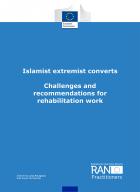Details
- Publication date
- 16 December 2021
- Author
- Directorate-General for Migration and Home Affairs
- RAN Publications Topic
- Islamist extremism
Description
According to the available data, the number of converts to Islam varies significantly per Country and moves from a percentage, among the total Muslim population, of 0.3/4.5 in Germany to 23 in the United States, but their involvement in Jihadist movements seems to be overrepresented (from 6 to 23 percent of foreign fighters from various Western European countries and probably up to 40% of the US foreign fighters are converts , which highlights the need to take a closer look at what seems to make this group more vulnerable to extremist propaganda.
Unfortunately, systematic research that analyses in depth the possible link between conversion and radicalisation are still in their infancy and the scarcity of useful data complicates the understanding of the motifs and the modalities with which converts can become part of the Jihadist violent global plan and the implementation of efficient rehabilitation strategies. Anyway, treating converts as a monolithic group of potential terrorists creates misconceptions because each convert follows a personal path towards Islam and has in common with the others only the religious interest and the cultural background of origin.
The majority of converts will never approach radicalisation nor be involved in terrorist acts. For these reasons, conversion to Islam must not be considered a default security issue. When approaching the topic, the lack of knowledge of the “why” and the “how” of the converts’ radicalisation and an exhaustive description of possible rehabilitation strategies becomes evident. But why would such information be pivotal? Do converts radicalise differently than Islamist extremists with a Muslim cultural or family background? And, if yes, how?
Although the answers to these questions are relevant to understand the existing challenges and the possible rehabilitation strategies for this specific target group, it is worth remembering that:
“Both religious conversion and radicalization are similar in that they both involve significant changes in beliefs, attitudes and behaviors however, radicalization differs as a process in that the new beliefs, attitudes and behaviors occurring as a result of conversion are heightened and polarized in preparation for engaging in some form of violence”
The current knowledge about why Muslim converts seem to face a higher risk of radicalisation than the native-born Muslims is still not extensive enough to provide conclusive answers.
However, the following text will aim to collect and present the existing knowledge on particular challenges related to their rehabilitation process to provide some insights for P/CVE practice. The aim is to sensitise practitioners working with extremist converts regarding some of the most relevant issues around conversion and extremism and to provide some indications regarding potential pathways for deradicalisation, exit work and rehabilitation.

